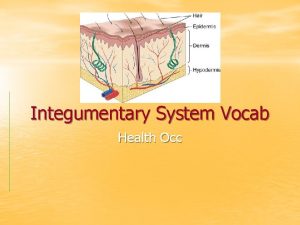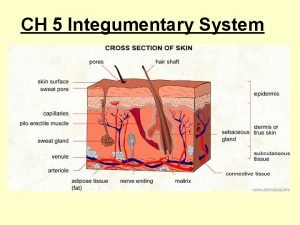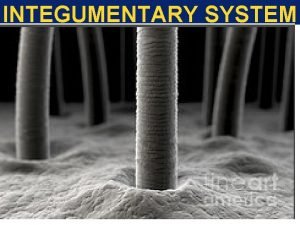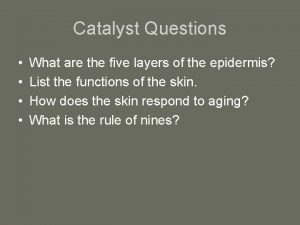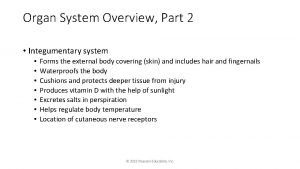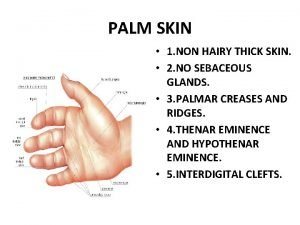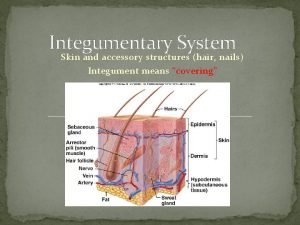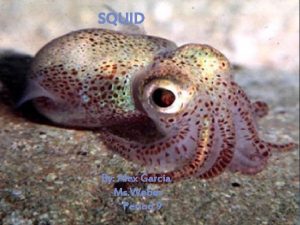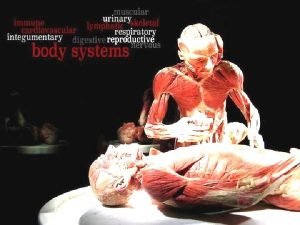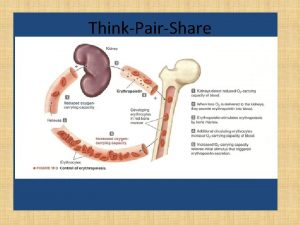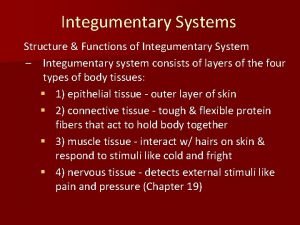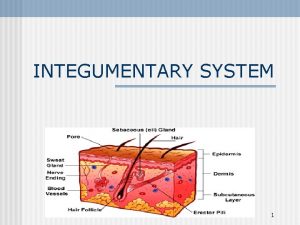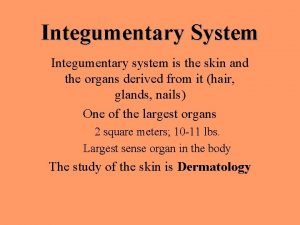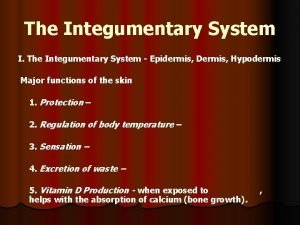CHAPTER 6 The Integumentary System Structure of the








































- Slides: 40

CHAPTER 6 The Integumentary System

Structure of the Skin 6 -2

The Integumentary System Overview Largest organ (15% of body weight) Composed of several tissue types (Epithelial, Connective, Muscle, and Nervous) Maintains homeostasis Protective covering Retards water loss Regulates body temperature Houses sensory receptors Contains immune system cells Synthesizes vitamin D Excretes small amounts of wastes

Layers of the Skin 4 Copyright © The Mc. Graw-Hill Companies, Inc. Permission required for reproduction or display. • Epidermis Stratified squamous epithelium • Dermis • Subcutaneous layer Dense irregular connective tissue Adipose tissue © The Mc. Graw-Hill Companies, Inc. /Al Telser, photographer

Epidermis Outermost layer Composed mostly of Stratified squamous epithelia Lacks blood vessels Keratinized Thickest on palms and soles (0. 8 -1. 4 mm) Contains 4 distinct cell types and 5 distinct layers

Cell and Layers of the Epidermis 6 -6

Cell Types of the Epidermis 1. Keratinocytes – produce keratin, a fibrous protein that give the epidermis its protective properties. These cells are tightly connected by desmosomes. They arise from the stratum basale. They undergo continuous mitosis. Friction may lead to a thickening of the cells known as a callus(corn).

Cell Types of the Epidermis 2. Melanocytes – synthesize melanin. 3. Located at the deepest layer of the epidermis. The melanin is transferred to the keratocytes. Protects against UV damage. Langerhans’ cells – arise from the bone marrow. Act as macrophages that activate the immune system.

Cell Types of the Epidermis 4. Tactile or Merkel cells – present at the junction of the epidermis and dermis. Associated with sensory receptors.

Layers of the Epidermis Thick skin (on palms, fingertips, soles) has 5 strata Thin skin has only 4 strata. The stratum lucidum is absent and the other layers are visibly thinner. The 5 layers are the: • stratum basale • stratum spinosum • stratum granulosum • stratum lucidum • stratum corneum

Stratum Basale Deepest layer Attached to the dermis. Sometimes called the stratum germinativum because of the constant mitosis that occurs there Made of a single row of keratinocytes Stratum Basale

Stratum Spinosum Several layers thick Consist mainly of keratin-like filaments. Resist tension Melanin granules and dendritic (Langerhan’s) cells are abundant in this layer Stratum Spinsum

Stratum Granulosum 3 to 5 layers Flat keratinocytes Contain more keratin and lamellate granules Stratum Granulosum

Stratum Lucidum Thin layer of dead kertinocytes. Present only in thick skin Stratum Lucidum

Stratum Corneum Up to 30 layers of dead, scaly, highly keratinized cells Cell membranes are thick surface cells flake off (exfoliate) “Cornified”

The Dermis Made mostly of connective tissue Richly innervated and vascularized Contains the hair follicles, sweat glands, oil glands, lymphatic & blood vessels, and many sensory receptors Consist of 2 layers Papillary layer – heavily vascularized, areolar connective tissue. Contains the dermal papillae, capillary loops, and Meissner’s corpuscles. Reticular layer – dense irregular connective tissue


The Subcutaneous or Hypodermis Superficial fascia – it is composes of areolar connective and adipose tissue. Functions: Connects the dermis to the underlying muscles Protects the underlying structures Stores fats and provide insulation

Skin Colors (Pigmentation) Skin color is determined by: Hemoglobin = red pigment of red blood cells Carotene = yellow pigment concentrates in stratum corneum and fat Melanin = yellow, brown, and black hues pigment synthesis stimulated by UV radiation

Discolorations of the Skin Cyanosis – skin appearance is bluish in color. Erythema – skin appearance is reddish in color. Pallor – paleness Jaundice - skin appearance is yellowish in color. Albinism – a genetic lack of melanin Bruises & hematomas


Accessory Organs of the Skin Sweat glands or Sudoriferous – more than 2. 5 million person. Coiled in the dermis, a duct leads to a pore at the skin’s surface 2 types Eccrine sweat glands – most numerous sweat glands Apocrine sweat glands – in the axillary and analgenital areas. Empty into the hair follicles. Contain fatty substances and proteins. May cause body odor. Begin to function at puberty. May contain pheromones. Secretion is thicker and milky.

Accessory Organs of the Skin Ceruminous glands – secrete earwax. Sebaceous glands – oil glands. Found everywhere except the palms and soles. Secrete sebum, usually into the hair follicles. Acts as a bactericide An accumulation of sebum causes a pimple.

Skin Appendages Hair – covers the entire body except for the palms, soles, lips, nipples, and parts of the genitalia. Mostly dead keratinized cells. Three (3) parts: Hair shaft Hair follicle Hair root

Hair shaft – protrudes above the skin Hair follicle - is oblique tube within the skin Consist of the medulla, cortex, and cuticle Hair root – Consist hair of the: bulb Root hair plexus Arector pili Hair papilla

Hair color Genes that direct the type and amount of pigment produced by epidermal melanocytes determine hair color. Bright red hair contains an iron pigment (trichosiderin) that does not occur in hair of any other color. Gray hair is the result of a mixture of pigmented and unpigmented hair.

Hair Growth and Loss Hair cycle = 3 repeating cycles Anagen is growth stage (90% of scalp follicles) lasts 6 -8 years in young adult Catagen is shrinking follicle (lasts 2 -3 weeks) Telogen is resting stage (lasts 1 -3 months) Thinning or baldness = alopecia Pattern baldness = genetic and hormonal sex-influenced trait(dominant in males, recessive in females); expressed only with high testosterone levels Hirsutism = excessive hair growth hormone imbalance (ovary or adrenal cortex problem) 6 -27


Alopecia

Hirsutism

Functions of Hair Body hair (too thin to provide warmth) alert Scalp hair heat us to parasites crawling on skin retention and sunburn cover Beard, pubic and axillary hair indicate sexual maturity and help distribute sexual scents Guard hairs and eyelashes prevent foreign objects from getting into nostrils, ear canals or eyes Expression of emotions with eyebrows 6 -31

Nails Modification of the epidermis Composed of densely packed cells filled with hard keratin Consist of a free edge, body, and root Nail bed – skin where the nail plate rests Nail matrix – growth occurs here Copyright © The Mc. Graw-Hill Companies, Inc. Permission required for reproduction or display. Lunula Nail bed Nail plate Lunula – the whitish, half-moon region located at the base of the nail plate

Fingernail Structure 6 -33

Skin Cancer Induced by UV rays of the sun Basal cell carcinoma (least dangerous) arises from stratum basale and invades dermis Squamous cell carcinoma arises from keratinocytes in stratum spinosum metastasis to the lymph nodes can be lethal Malignant melanoma (most deadly) arises from melanocytes of a preexisting mole ABCD rule - asymmetry, border irregular, color and diameter over 6 mm 6 -34


Burns Can be caused by hot water, sunlight, radiation, electric shock or acids and bases Denaturation of cell proteins Dehydration, protein loss, and infection can occur Degrees of burns 1 st-degree = only the epidermis (red, painful and edema) 2 nd-degree = epidermis and part of dermis (blistered) 3 rd-degree = epidermis, dermis and more is destroyed epidermis regenerates from hair follicles and sweat glands often requires grafts or fibrosis and disfigurement may occur Treatment – IV nutrition and fluid replacement, debridement and infection control 6 -36

Burns

Skin Grafts and Artificial Skin Third-degree burns require skin grafts Graft options autograft -- tissue from the patient isograft -- tissue from identical twin cultured keratinocyte patches Temporary grafts (immune system) homograft (allograft) -- from unrelated person heterograft (xenograft) -- from another species amnion from afterbirth artificial skin from silicone and collagen 6 -38


 Unit 3 integumentary system
Unit 3 integumentary system Chapter 6 integumentary system
Chapter 6 integumentary system Epidermis
Epidermis Integumentary system vocabulary
Integumentary system vocabulary Integumentary system pig
Integumentary system pig Integument adalah
Integument adalah The integumentary system facts
The integumentary system facts Exercise 7 the integumentary system
Exercise 7 the integumentary system Integumentary system vocabulary
Integumentary system vocabulary Exfoliative dermatitis
Exfoliative dermatitis The integumentary system
The integumentary system Integumentary system assessment
Integumentary system assessment Integumentary system analogy
Integumentary system analogy Cat integumentary system
Cat integumentary system The integumentary system
The integumentary system Figure 5-1 the components of the integumentary system
Figure 5-1 the components of the integumentary system Integumentary system effects of aging
Integumentary system effects of aging Section 36-3 the integumentary system
Section 36-3 the integumentary system Integumentary system
Integumentary system Integumentary system
Integumentary system Homeostatic imbalances
Homeostatic imbalances Integumentary system histology labeled
Integumentary system histology labeled 6 functions of the integumentary system
6 functions of the integumentary system Anatomy and physiology of psoriasis
Anatomy and physiology of psoriasis Urinary system interesting facts
Urinary system interesting facts Integumentary system
Integumentary system Integumentary system
Integumentary system Integumentary system cpt coding guidelines ppt
Integumentary system cpt coding guidelines ppt Contains several layers of polygonal keratinocytes
Contains several layers of polygonal keratinocytes Palm without skin
Palm without skin Nails integumentary system
Nails integumentary system Integumentary system
Integumentary system Excretory and integumentary system
Excretory and integumentary system Squid integumentary system
Squid integumentary system Body systems foldable
Body systems foldable Chapter 36 skeletal muscular and integumentary systems
Chapter 36 skeletal muscular and integumentary systems Pacinian corpuscle histology
Pacinian corpuscle histology How do you pronounce integumentary
How do you pronounce integumentary Organization of the lymphatic system
Organization of the lymphatic system Hình ảnh bộ gõ cơ thể búng tay
Hình ảnh bộ gõ cơ thể búng tay








